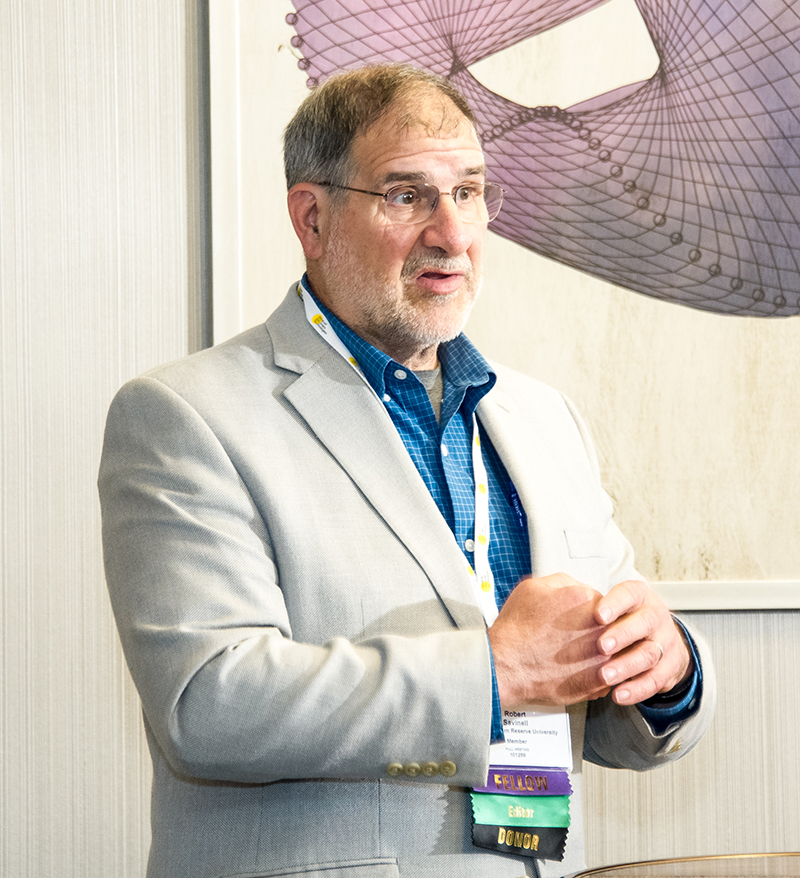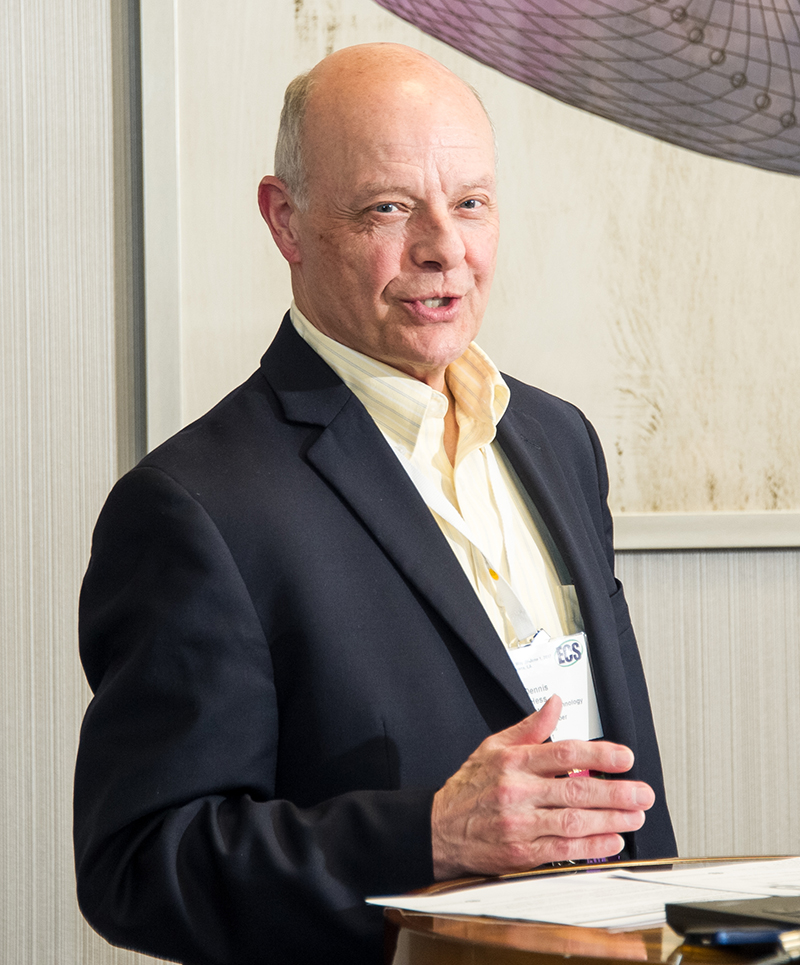In May 2017, we sat down with ECS journal editors Robert Savinell and Dennis Hess at the 231st ECS Meeting to discuss the future of scholarly publishing, open access, and the Society’s Free the Science initiative. The conversation was led by Rob Gerth, director of marketing and communications at ECS.
In 1978, Savinell became an active member of ECS, serving as an associate editor for the Journal of The Electrochemical Society (JES) in 1984. He was appointed editor of JES in 2013, where he began focusing on continuing the tradition of rigorous review, enhancing timeliness of decision and publication, while transitioning JES to full open access. Savinell has recently been reappointed as editor JES for a three-year period, from May 18, 2017 through May 17, 2020.
Hess became a member of ECS in 1974. He has been active in both the ECS Dielectric Science and Technology and Division and ECS Electronics Division, serving as a divisional editor from 1978 through 1990. Currently, Hess is the editor of the ECS Journal of Solid State Science and Technology.
Listen to the podcast and download this episode and others for free through the iTunes Store, SoundCloud, or our RSS Feed. You can also find us on Stitcher.
Rob Gerth: What does open science mean to you?
Robert Savinell: To me, open science means accessibility to the research. It means having others be able to access the research in a way that is not controlled by a third party. It’s where you make a decision about what point you want it to become accessible.
Dennis Hess: The openness of the science means that other people can use it to add to it, to embellish it, and to find new applications. If there’s any kind of restriction on it, that restricts the knowledge base, and the ability to develop new products and apply creativity. Any results you generate are accessible to anyone, anywhere, at any time. You’re not limited by whether you can afford to pay to access the information or whether anyone who’s funded says this is restricted.
RG: The Society has a certain stance as far as for-profit versus nonprofit goes. We’ve taken the stance that our job is dissemination the information, not to make money from the information. Compare and contrast the nonprofits with the for-profits.
DH: The driving force for a company that depends on making a profit is just that. When it comes down to what material to publish, the profit will generally win out. They’re in business to make a profit. That has to be high on the list when you start making decisions. There’s always a choice to whether you publish a certain article or not. There are articles that should clearly be published because they’re outstanding work, there are article that clearly shouldn’t be published, and then the majority of them fall somewhere in between that. You make decisions based on what your feeling is and what reviewers you select. Ultimately, the decision comes down to the editor handling the paper. You need numbers. The decision to publish or not can be clouded by that.
The Society looks to disseminate valid knowledge, and knowledge that promotes and furthers the field. If you do that, then you’re trying to make decisions based on the quality. When for-profit publishers get into this conflict of how to make decisions, there’s always a chance that you’ll decide for reasons other than scientific or technological.

Robert Savinell, editor of the Journal of The Electrochemical Society, during the 231st ECS Meeting.
RS: To take it one step further, some of these journals look at the quality of the science and they may do an assessment through a peer-review and they find out the quality of the science is high. But they still may not publish the paper because it doesn’t have the current interest; it doesn’t have a pizzazz to it. It may be very solid work that resolves an issue, but the editor makes a decision that it’s not out in front enough that it will garner enough attention to get citations. It may be an important piece of work that may be worth something 10 years from now, but at this point it’s not going to be all that exciting for a broad audience and therefore they don’t accept it.
However, a journal from a professional society like ECS, will look at the value of the science as the value of the science and not necessarily what its pizzazz is at that particular time. I think that’s one of the reasons we have this 10 year impact factor that’s at the top of the list. We’re looking at quality of the science in the long term.
RG: Was publishing always a big business?
DH: I would say the big business aspects of publishing didn’t start until 15 to 20 years ago. Up until then, it was much more feedback and interaction from colleagues and peers. When the Society began, it was the Transactions of the American Electrochemical Society. In those cases, there was more debate than there was data. That was that interaction to check and see if you forget something, examining another way to look at this, or asking if there is an extension of this that would give me more insight. Now it’s become much more of who will purchase this knowledge if I make it available. So it’s much more secretive, there’s much more interest in intellectual property; the whole thing has become much more of how do I make a profit from this. That includes not only the research, but also the dissemination of the research.
RG: Can nonprofit publishers compete with for-profit publishers?
RS: I think there’s a lot of value in this concept of having a quality peer-reviewed place where you can deposit research information and have it disseminated very broadly and have quality that is going to be sustained over a long period of time. I think there’s a need for that. I would say an organization like ECS can compete because it doesn’t have this short term constraint like a for-profit would because they want to attract many authors and have a high impact factor, which builds up the profitability. ECS doesn’t have that profitability driving force, so we can accept articles that will have long term value, which will be very important to the research community in the future and for society to have that.
RG: What’s the complication with open access? Some for-profit journals are doing open access, but what have been some of the risks associated with open access?
RS: There’s a perception problem in some cases. Some publishers have introduced journals that are open access and they’ve been able to make it open access by having a relatively minor peer review process. They can make it lower cost, put more manuscripts through the system, and when they get the income from doing this they can make more profits. There’s a concept in some circles that by having open access, that’s a term for saying you paid to have your research published that’s not necessarily critically reviewed.
That’s one challenge we have as a professional society, is to deliver the message that all the work that we publish goes through a very rigorous peer review. If you look at the editorial board that we have that makes the decisions, these are all experts in the field. We can give critical feedback to the authors that can make the papers much stronger and much better.

Dennis Hess, editor of the ECS Journal of Solid State Science and Technology, during the 231st ECS Meeting.
DH: The idea of open access had been interpreted – and it still is sometimes – as a cursory review and then publish. If you chose to publish an article from someone who publishes a lot of papers and has a big reputation, the chances that they will publish more papers and cite that one is high. You can neglect the review process if you wish to do so, figuring this paper will get citations because at least they’ll cite themselves when they publish other things. I’ve seen that happen. That’s a way to game the system and it’s not really evaluated carefully prior to publication. If you want to do through reviews, it’s going to cost resources.
RG: What does Free the Science mean to you?
RS: It’s no cost to the author to make it free and no cost to the reader or scientific community to take that information and use it to develop further understanding or new products to improve quality of life. It’s about making the science available to grow and to mature and to rise to get the cream to rise to the top so it can serve society. The tricky part is to support the cost of the infrastructure that is really needed to have peer review and be able to put that information into an accessible archive and provide the support to maintain it so it’s available for the next 1,000 years.
DH: It’s about sustainability. What we’re trying to do is have a system in place that’s sustainable. One where you can continue to operate and supply information without restrictions so that you’ve freed the science and it isn’t restricted in any way.
RS: Ultimately it’s about improving the quality of life for humankind.
Download the podcast to hear the full conversation.


